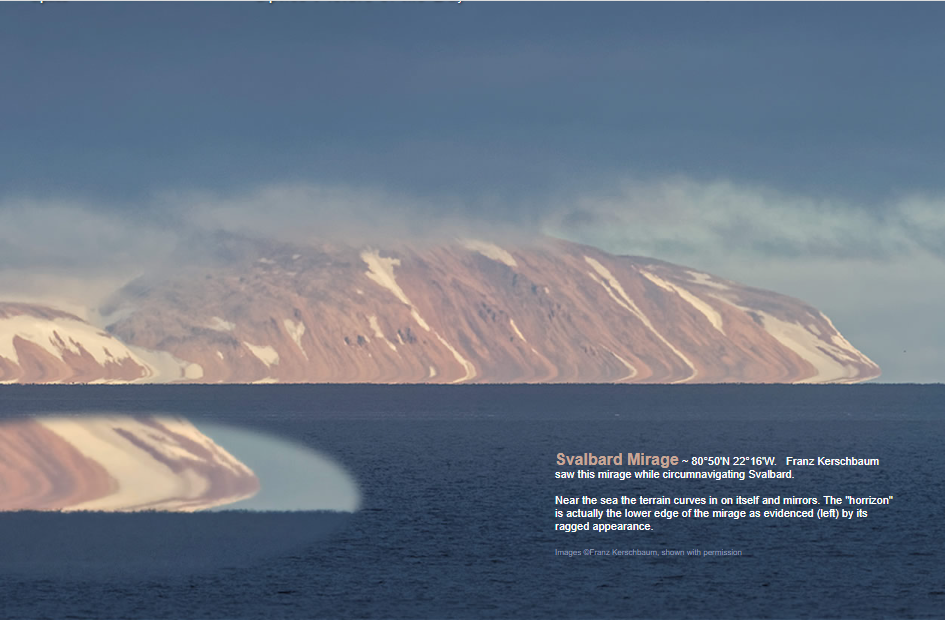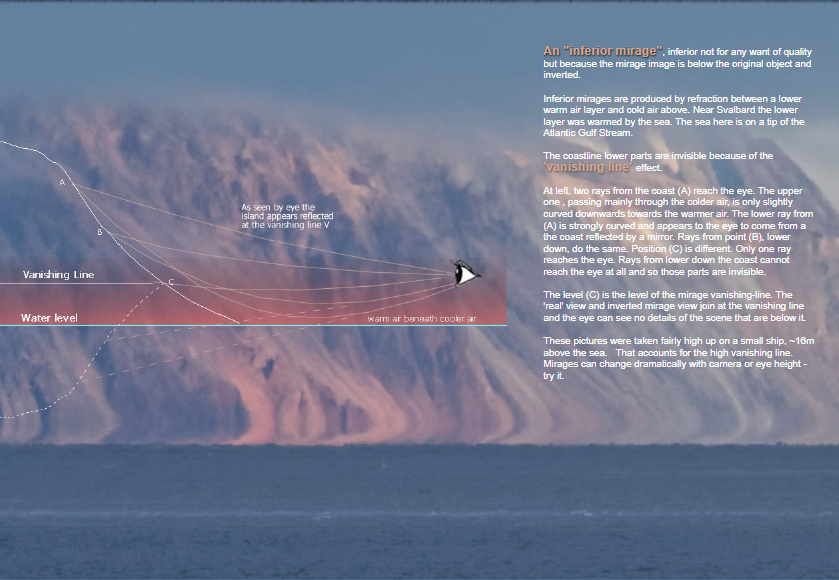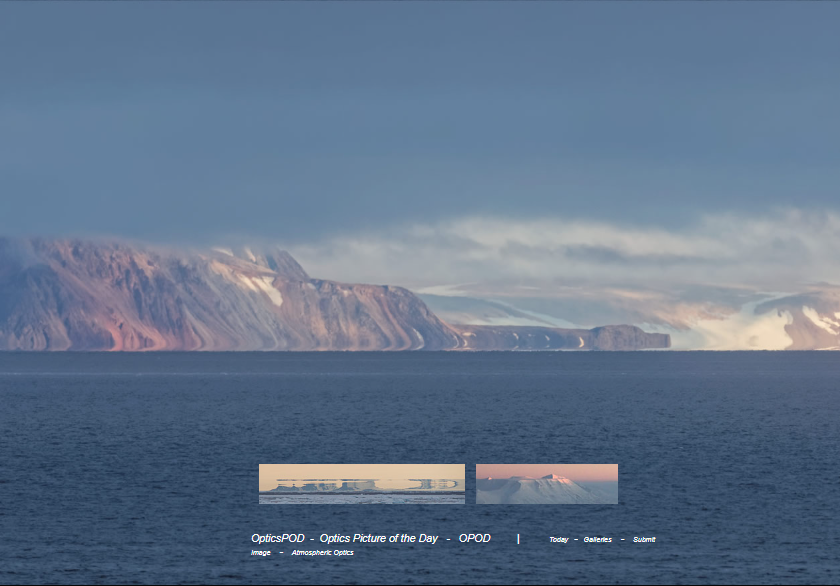Svalbard Inferior Mirage - OPOD
Svalbard Inferior Mirage - An Optical Phenomenon Explained
In the enchanting region of Svalbard, located approximately 80°50'N 22°16'W, a captivating atmospheric optical phenomenon known as the Svalbard Inferior Mirage occasionally graces the observers. This mirage was first witnessed by Franz Kerschbaum during his circumnavigation of Svalbard. The images captured by Kerschbaum offer a glimpse into the fascinating world of mirages and the mesmerizing effects they create.
Unveiling the Illusion
At first glance, the Svalbard Mirage may appear perplexing. The mirage creates an illusionary "horizon" that seems to defy the laws of nature. However, upon closer inspection, we discover that this "horizon" is actually the lower edge of the mirage, characterized by its slightly distorted and ragged appearance. This optical phenomenon occurs when the terrain near the sea curves in on itself, giving rise to a mirror-like effect.
The Intriguing Inferior Mirage
The Svalbard Mirage falls under the category of an "inferior mirage." Contrary to what the name may suggest, the term "inferior" does not imply any lack of quality or beauty in the mirage itself. Instead, it refers to the position of the mirage image, which appears below the original object and inverted.
Inferior mirages are formed through a process called refraction. In the case of the Svalbard Mirage, this refraction occurs between a lower layer of warm air and a colder layer of air above it. The lower layer of air near Svalbard is heated by the adjacent sea, which benefits from the warm waters of the Atlantic Gulf Stream.
The Vanishing Line Effect
As we delve deeper into understanding the Svalbard Inferior Mirage, we encounter a fascinating phenomenon known as the "vanishing line" effect. This effect renders the lower parts of the coastline invisible to the observer. Let's explore how this optical trickery unfolds:
- Two rays from a point on the coast (point A) reach the observer's eye. The upper ray, passing through the colder air, undergoes minimal curvature downwards towards the warmer air.
- On the other hand, the lower ray from point A experiences significant curvature, creating the illusion that it originates from a coast reflected by a mirror.
- This phenomenon is not limited to point A alone; rays from other points along the coast, such as point B, also exhibit similar behavior.
- However, at a different position (point C), only one ray manages to reach the observer's eye. As we move further down the coast, rays from lower points become unable to reach the eye at all, rendering those areas invisible.
The Enigmatic Vanishing Line
The level represented by point C is what we refer to as the mirage vanishing line. At this level, the "real" view and the inverted mirage view intersect, obscuring any details of the scene that lie below it. This creates a visual boundary beyond which certain elements become imperceptible to the observer.
It is worth noting that the height at which an observer stands can significantly influence the appearance of mirages. In the case of Kerschbaum's images, they were captured from a relatively high vantage point on a small ship, approximately 16 meters above sea level. This elevated position accounts for the higher vanishing line observed in these images. It is an intriguing reminder of how mirages can undergo dramatic transformations based on the height of the observer, whether through a camera or the naked eye.
Conclusion
The Svalbard Inferior Mirage stands as a testament to the captivating wonders of atmospheric optics. Through refraction and the interplay between warm and cold air layers, this optical phenomenon creates an illusionary mirage that astounds and mesmerizes observers. The intricate nature of the vanishing line effect further adds to the allure, rendering certain parts of the coastline invisible to the human eye.
As we continue to explore the realm of atmospheric optics, the Svalbard Inferior Mirage serves as a reminder of the hidden complexities that lie within our natural world. By delving deeper into these phenomena, we gain a greater appreciation for the marvels that surround us and the intricate interplay between light, air, and perception.

Svalbard Mirage ~ 80°50'N 22°16'W. Franz Kerschbaum saw this mirage while circumnavigating Svalbard.
Near the sea the terrain curves in on itself and mirrors. The "horrizon" is actually the lower edge of the mirage as evidenced (left) by its ragged appearance.
Images ©Franz Kerschbaum, shown with permission

An "inferior mirage", inferior not for any want of quality but because the mirage image is below the original object and inverted.
Inferior mirages are produced by refraction between a lower warm air layer and cold air above. Near Svalbard the lower layer was warmed by the sea. The sea here is on a tip of the Atlantic Gulf Stream.
The coastline lower parts are invisible because of the 'vanishing line' effect.
At left, two rays from the coast (A) reach the eye. The upper one , passing mainly through the colder air, is only slightly curved downwards towards the warmer air. The lower ray from (A) is strongly curved and appears to the eye to come from a the coast reflected by a mirror. Rays from point (B), lower down, do the same. Position (C) is different. Only one ray reaches the eye. Rays from lower down the coast cannot reach the eye at all and so those parts are invisible.
The level (C) is the level of the mirage vanishing-line. The 'real' view and inverted mirage view join at the vanishing line and the eye can see no details of the scene that are below it.
These pictures were taken fairly high up on a small ship, ~16m above the sea. That accounts for the high vanishing line. Mirages can change dramatically with camera or eye height - try it.

Note: this article has been automatically converted from the old site and may not appear as intended. You can find the original article here.
Reference Atmospheric Optics
If you use any of the definitions, information, or data presented on Atmospheric Optics, please copy the link or reference below to properly credit us as the reference source. Thank you!
-
<a href="https://atoptics.co.uk/blog/svalbard-inferior-mirage-opod/">Svalbard Inferior Mirage - OPOD</a>
-
"Svalbard Inferior Mirage - OPOD". Atmospheric Optics. Accessed on November 8, 2024. https://atoptics.co.uk/blog/svalbard-inferior-mirage-opod/.
-
"Svalbard Inferior Mirage - OPOD". Atmospheric Optics, https://atoptics.co.uk/blog/svalbard-inferior-mirage-opod/. Accessed 8 November, 2024
-
Svalbard Inferior Mirage - OPOD. Atmospheric Optics. Retrieved from https://atoptics.co.uk/blog/svalbard-inferior-mirage-opod/.